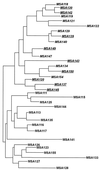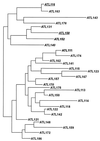Molecular epidemiology of metronidazole resistance in a population of Trichomonas vaginalis clinical isolates
- PMID: 10921968
- PMCID: PMC87171
- DOI: 10.1128/JCM.38.8.3004-3009.2000
Molecular epidemiology of metronidazole resistance in a population of Trichomonas vaginalis clinical isolates
Abstract
Trichomonas vaginalis, the causative agent for human trichomoniasis, is a problematic sexually transmitted disease mainly in women, where it may be asymptomatic or cause severe vaginitis and cervicitis. Despite its high prevalence, the genetic variability and drug resistance characteristics of this organism are poorly understood. To address these issues, genetic analyses were performed on 109 clinical isolates using three approaches. First, two internal transcribed spacer (ITS) regions flanking the 5.8S subunit of the ribosomal DNA gene were sequenced. The only variation was a point mutation at nucleotide position 66 of the ITS1 region found in 16 isolates (14.7%). Second, the presence of a 5.5-kb double-stranded RNA T. vaginalis virus (TVV) was assessed. TVV was detected in 55 isolates (50%). Finally, a phylogenetic analysis was performed based on random amplified polymorphic DNA data. The resulting phylogeny indicated at least two distinct lineages that correlate with the presence of TVV. A band-sharing index indicating relatedness was created for different groups of isolates. It demonstrated that isolates harboring the virus are significantly more closely related to each other than to the rest of the population, and it indicated a high level of relatedness among isolates with in vitro metronidazole resistance. This finding is consistent with the hypothesis that drug resistance to T. vaginalis resulted from a single or very few mutational events. Permutation tests and nonparametric analyses showed associations between metronidazole resistance and phylogeny, the ITS mutation, and TVV presence. These results suggest the existence of genetic markers with clinical implications for T. vaginalis infections.
Figures





References
-
- Chakrabarti D, Dame J B, Gutell R R, Yowell C A. Characterization of the rDNA unit and sequence analysis of the small subunit rRNA and 5.8S rRNA genes from Tritrichomonas foetus. Mol Biochem Parasitol. 1992;52:75–84. - PubMed
-
- Cotch M F, Pastorek J G, Nugent R P, Hillier S L, Gibbs R S, Martin D H, Exchenbach D A, Edelman R, Carey C, Regan J A, Drohn M A, Kebanoff M A, Vijaya A, Rhoads G G the Vaginal Infections and Prematurity Study Group. Trichomonas vaginalis associated with low birth weight and preterm delivery. Sex Transm Dis. 1997;24:1–8. - PubMed
-
- Diamond L S. The establishment of various trichomonads of animals and man in axenic cultures. J Parasitol. 1957;43:488–490. - PubMed
-
- Flegr J, Zaboj P. PTPT, the freeware program for permutation testing concordance between phylogeny and the distribution of phenetic traits. Acta Soc Zool Bohem. 1998;61:91–95.
-
- Gunderson J, Hinkle G, Leipe D, Morrison H G, Stickel S K, Odelson D A, Breznak J A, Nerad T A, Muller M, Sogin M L. Phylogeny of trichomonads inferred from small-subunit rRNA sequences. J Eukaryot Microbiol. 1995;42:411–415. - PubMed
Publication types
MeSH terms
Substances
LinkOut - more resources
Full Text Sources
Medical

